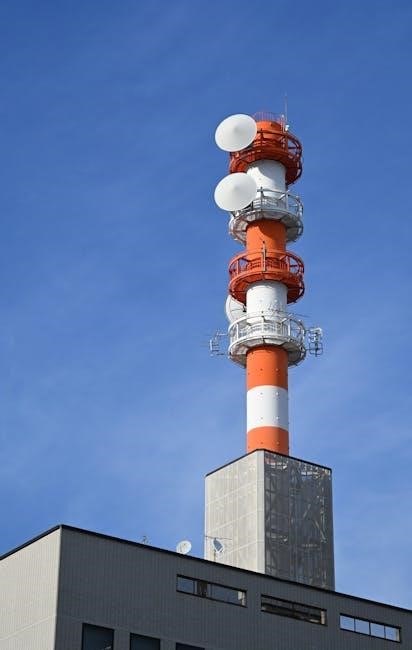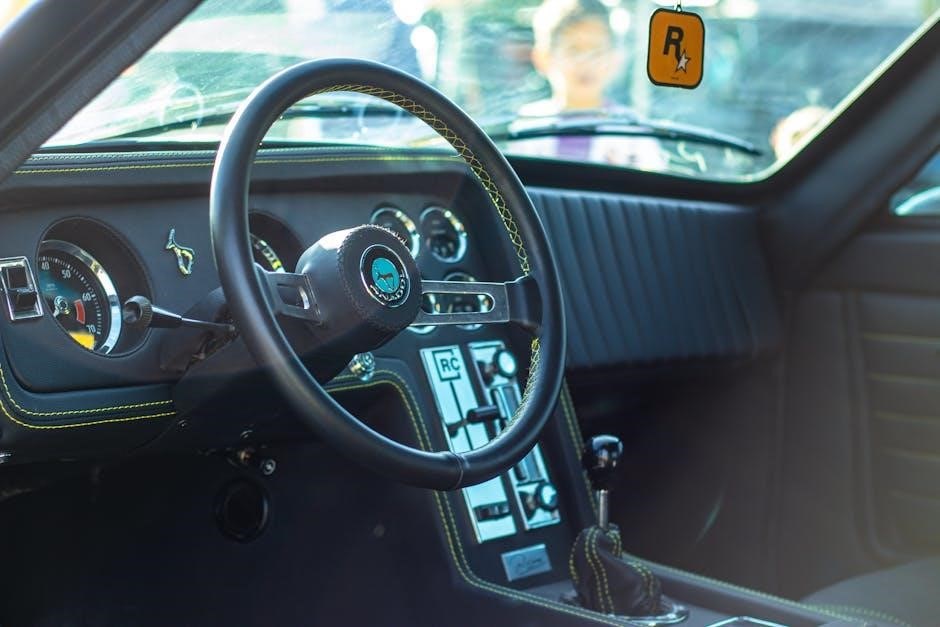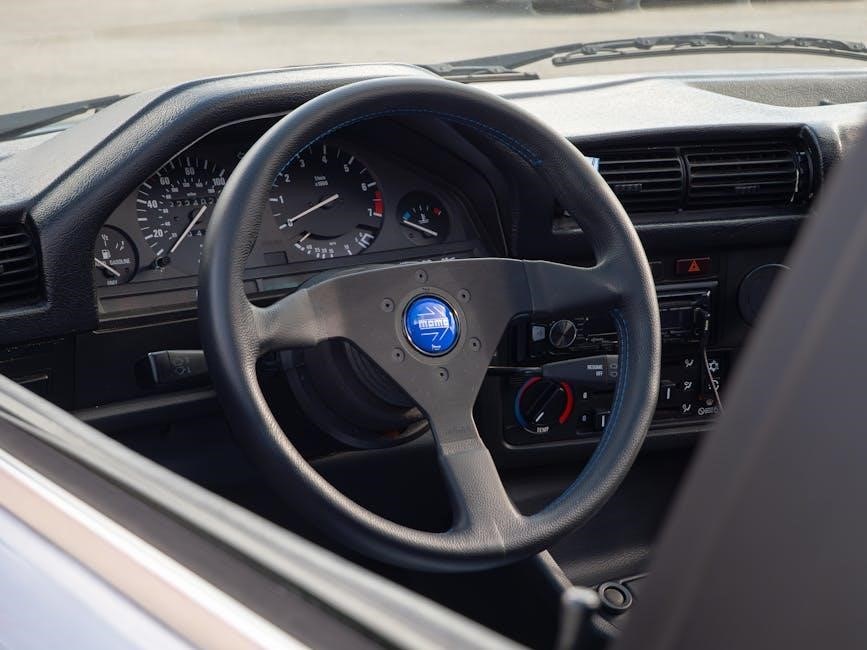Enthusiasts are increasingly exploring manual transmission swaps in 6.7 Powerstroke trucks, seeking enhanced control and a more engaging driving experience. This modification presents unique challenges.
The 6.7 Powerstroke, typically paired with an automatic, can be adapted for a manual gearbox, though it requires careful planning and specific parts sourcing.
Popular choices include the ZF-6 or ZF-5 speed transmissions, offering robust performance. The swap isn’t simple, but the rewards are substantial for dedicated owners.
Overview of the 6.7 Powerstroke Engine
The 6.7-liter Power Stroke diesel engine, introduced in 2011, represents a significant advancement in Ford’s Super Duty lineup. It features a cast iron block, a forged steel crankshaft, and updated cylinder heads for improved durability and performance.
Initially producing around 390 horsepower and 735 lb-ft of torque, later iterations saw increases to 440 horsepower and 860 lb-ft. This engine utilizes a common-rail fuel injection system and a variable geometry turbocharger.
While commonly paired with a TorqShift automatic transmission, its robust construction makes it a viable candidate for manual transmission conversions, appealing to drivers desiring greater control.
Why Consider a Manual Transmission Swap?
For many diesel truck enthusiasts, the allure of a manual transmission lies in the enhanced driver engagement and control it provides. Swapping to a manual in a 6.7 Powerstroke offers a more direct connection to the engine’s power, appealing to those who enjoy a traditional driving experience.
Some owners seek to avoid the complexities and potential failures of the automatic transmission. A manual swap can also potentially improve fuel economy, though gains may be modest.
Ultimately, it’s about personal preference and a desire for a more involved driving experience.

Feasibility of a Manual Swap
A manual swap on a 6.7 Powerstroke is achievable, but not straightforward. It demands significant mechanical skill, specialized parts, and careful consideration of modifications.
Is a Manual Swap Possible on a 6.7 Powerstroke?
Yes, a manual transmission swap is indeed possible on a 6.7 Powerstroke, as demonstrated by numerous successful conversions documented online. However, it’s not a plug-and-play operation. The engine wasn’t originally designed for a manual, necessitating substantial modifications.
Owners have successfully installed ZF-6 and ZF-5 speed transmissions, proving the mechanical feasibility. The primary hurdle lies in adapting the vehicle’s computer and wiring to function correctly with the manual gearbox, alongside addressing the pedal assembly and driveshaft requirements.
It requires dedication and expertise.
Challenges and Considerations
Undertaking a 6.7 Powerstroke manual swap presents significant challenges. Wiring harness modifications are crucial, often requiring custom solutions to integrate with the Powertrain Control Module (PCM). Finding a compatible flywheel and clutch assembly can also be difficult.
Driveshaft modifications are almost guaranteed, needing proper length and balancing. Hydraulic line routing for the clutch master and slave cylinders requires careful planning. Furthermore, ensuring emissions compliance post-swap is a key consideration.
It’s a complex project demanding expertise.

Transmission Options
Several manual transmissions are viable for a 6.7 Powerstroke swap, notably the robust ZF-6 speed, the ZF-5 speed, and older New Process Gear (NP) options.
Each offers different gear ratios and strength characteristics, influencing performance and drivability.
ZF-6 Speed Transmission
The ZF-6 speed transmission is a highly sought-after choice for 6.7 Powerstroke manual swaps, prized for its durability and smooth shifting characteristics. Originally found in certain Ford trucks, it offers a comfortable overdrive gear for highway cruising.
Sourcing a ZF-6 requires diligent searching, as it wasn’t a common factory option. Adapting it involves an input shaft spline match to the transfer case, often requiring an adapter plate. This transmission provides a substantial upgrade over the factory automatic, enhancing driver engagement and control.
It’s considered a premium option due to its strength and refinement.
ZF-5 Speed Transmission
The ZF-5 speed transmission presents a more readily available, and often more affordable, alternative to the ZF-6 for 6.7 Powerstroke manual swaps. While not as refined as its 6-speed counterpart, it remains a robust and capable option for those seeking a manual driving experience.
Like the ZF-6, adapting the ZF-5 requires attention to input shaft splines and potential adapter plate needs for proper transfer case compatibility. It’s a popular choice for builds prioritizing cost-effectiveness without sacrificing significant durability.
It offers a direct and engaging feel.
New Process Gear (NP) Transmissions
New Process Gear (NP) transmissions, specifically the NP435 and NP545, represent older, yet incredibly durable, manual transmission options for the 6.7 Powerstroke swap. These transmissions are known for their simplicity and ability to handle significant torque, making them suitable for heavily modified engines.
However, utilizing an NP transmission necessitates more extensive modifications due to their age and differing mounting configurations compared to the ZF units. Adapter plates and custom fabrication are almost always required.
They offer a rugged, old-school feel.

Parts Required for the Swap
A successful 6.7 Powerstroke manual swap demands a comprehensive parts list: transmission, flywheel, clutch, pedal assembly, hydraulics, crossmember, driveshaft, and PCM adjustments.
Sourcing these components requires diligent research and careful consideration of compatibility.
Transmission Itself
The core of the swap is, naturally, the manual transmission. The ZF-6 speed is a highly sought-after option, known for its durability and smooth shifting, offering a substantial upgrade over the automatic.
Alternatively, the ZF-5 speed provides a more economical choice, though with fewer gears. New Process Gear (NP) transmissions are also viable, depending on desired ratios and strength.
Ensure the chosen transmission’s input spline matches the transfer case, potentially requiring an adapter plate. Thorough inspection and rebuild are recommended before installation for optimal reliability.
Flywheel and Clutch Assembly
A crucial component is the flywheel, replacing the automatic’s flexplate. It must be specifically designed for the 6.7 Powerstroke and the chosen transmission. Compatibility is paramount for proper operation and balance.
The clutch assembly – including the disc, pressure plate, and throw-out bearing – needs to match the flywheel and transmission’s torque capacity. Heavy-duty clutches are recommended for modified engines.
Proper alignment of the clutch disc during installation is vital to prevent premature wear and shifting issues. A pilot bearing or bushing is also essential for supporting the transmission input shaft.
Pedal Assembly (Clutch, Brake)
Since the 6.7 Powerstroke initially came with only an automatic transmission, a complete pedal assembly swap is necessary. This includes a clutch pedal, brake pedal, and potentially the associated mounting brackets.
Sourcing a pedal assembly from a compatible Ford truck with a manual transmission is the most common approach. Ensuring compatibility with the cab floor and linkage is crucial for a clean installation.
Adjustments to the pedal height and travel may be required for optimal driver comfort and control. Proper installation and secure mounting are essential for safety and reliable operation.
Master and Slave Cylinders
Hydraulic clutch systems require a master cylinder, typically mounted under the dash, and a slave cylinder, located on the transmission. These components translate pedal pressure into clutch fork movement.
Selecting the correct master and slave cylinder combination is vital for proper clutch engagement and disengagement. Pre-bleeding the master cylinder is often recommended to simplify the bleeding process later.
Stainless steel brake lines can be used for the hydraulic clutch lines to improve durability and reduce expansion under pressure. Careful attention to routing and secure mounting is essential to prevent leaks.
Transmission Crossmember
The factory automatic transmission crossmember will not work with a manual transmission due to differing lengths and mounting points. A custom-fabricated or aftermarket crossmember is essential for secure mounting.
The crossmember must be robust enough to support the weight of the manual transmission and withstand the stresses of driving. Accurate measurement and welding are critical for proper alignment.
Some kits include a pre-fabricated crossmember, simplifying the installation process. Ensuring adequate clearance for the driveshaft and exhaust system is also a key consideration during installation.
Driveshaft Modifications
Switching from an automatic to a manual transmission necessitates driveshaft modifications due to the change in transmission length. The original driveshaft likely won’t align correctly with the transfer case.
Typically, the driveshaft will need to be shortened and rebalanced to ensure proper rotation and prevent vibrations. New U-joints may also be required depending on the transmission and transfer case flanges.
Professional driveshaft balancing is highly recommended for longevity and smooth operation. Accurate measurements are crucial for a successful and reliable driveshaft modification.
Wiring Harness Modifications
The 6.7 Powerstroke’s wiring harness, designed for an automatic transmission, requires significant modification for a manual swap. Removing automatic transmission control signals is essential, and new wiring for manual-specific functions must be added.
This includes provisions for the clutch switch, potentially a transmission speed sensor, and adjustments to the neutral safety switch functionality. Careful attention to detail is paramount to avoid electrical issues.
Some swaps involve utilizing the original PCM with reprogramming, while others may require a different PCM altogether, further complicating the wiring process.
PCM (Powertrain Control Module) Considerations
The 6.7 Powerstroke’s PCM requires careful consideration during a manual transmission swap. The original PCM is programmed for an automatic, necessitating either reprogramming or replacement.
Reprogramming can remove automatic transmission control parameters and enable compatibility with the manual. However, a custom tune is often required for optimal performance and to address any error codes.
Alternatively, swapping to a PCM from a factory-manual equipped truck is an option, though finding a compatible unit can be challenging. Proper PCM integration is crucial for engine operation.

The Swap Process
The conversion begins with automatic transmission removal, followed by manual installation. Wiring harness modifications, hydraulic line routing, and driveshaft adjustments are essential steps.
PCM integration and proper calibration are vital for seamless operation. Careful attention to detail ensures a successful and reliable manual swap.
Removing the Automatic Transmission
Begin by disconnecting the driveshaft and shift linkage from the automatic transmission. Carefully drain the transmission fluid before unbolting the torque converter from the engine’s flexplate.
Support the transmission with a jack as you remove the mounting bolts, ensuring a controlled descent. Disconnect all electrical connectors and cooler lines. Lower the transmission carefully, navigating around exhaust components.
Inspect the flexplate for damage and replace if necessary. Prepare the bellhousing area for the manual transmission installation, ensuring a clean and unobstructed surface.
Installing the Manual Transmission
Carefully align the manual transmission with the engine’s bellhousing, utilizing a transmission jack for support and precise positioning. Install the flywheel and clutch assembly, ensuring proper torque specifications are followed.
Gradually raise the transmission into place, aligning the input shaft with the clutch disc. Secure the transmission with the mounting bolts, tightening them in a crisscross pattern. Connect the transfer case, verifying proper alignment.
Double-check all connections and clearances before proceeding to the next stage of the swap process, ensuring a secure and reliable installation.
Wiring and PCM Integration
Integrating a manual transmission requires modifying the vehicle’s wiring harness to remove automatic transmission signals and add manual transmission controls. A crucial step involves the PCM (Powertrain Control Module), potentially needing reprogramming or replacement.
Some swaps utilize the original PCM with wiring adjustments, while others necessitate a custom tune or aftermarket PCM to manage the manual transmission effectively. Ensure proper CAN bus communication.
Carefully trace and modify wiring according to the chosen method, verifying all connections for correct functionality and avoiding electrical issues.
Hydraulic Line Installation
Proper hydraulic line installation is critical for a functional manual transmission swap. This involves running new lines for the clutch master and slave cylinders, ensuring they are correctly sized and routed to avoid interference.
Bleeding the hydraulic system thoroughly is essential to eliminate air bubbles and achieve a firm clutch pedal feel. Use DOT 3 or DOT 4 brake fluid as recommended by the manufacturer.
Inspect all fittings for leaks after installation and during initial operation, tightening as needed. Secure the lines properly to prevent damage from vibration or road debris.
Driveshaft Installation and Balancing
After the manual transmission is in place, the driveshaft requires careful attention. The original automatic driveshaft likely won’t fit due to length differences, necessitating a custom driveshaft or modification.
Accurate measurement is crucial for proper fitment and avoiding vibrations. Driveshaft balancing is paramount, especially with the increased power of the Powerstroke engine, to ensure smooth operation.
Verify proper U-joint angles to minimize stress on the transmission and differential. A professionally balanced driveshaft will significantly improve the overall driving experience.

Cost Analysis
A 6.7 Powerstroke manual swap ranges from $3,000 to $8,000+, depending on parts chosen and labor. Unexpected costs often arise during complex modifications.
Budgeting for potential issues and professional assistance is vital for a successful and financially sound conversion.
Parts Costs
The transmission itself represents a significant expense, ranging from $1,500 to $4,000 depending on condition and model (ZF-6 being pricier). A flywheel and clutch assembly typically costs between $800 and $1,500.
Pedal assemblies can range from $300 to $600, while master and slave cylinders add another $200-$400. A custom transmission crossmember is often required, costing around $300-$500. Expect to spend $200-$600 on driveshaft modifications and potentially $100-$300 for wiring harness adjustments.
Finally, PCM considerations may necessitate reprogramming or a new module, adding $300-$800 to the total.
Labor Costs (If Applicable)
Professional installation of a manual transmission swap on a 6.7 Powerstroke is a complex undertaking. Labor rates vary significantly by region and shop expertise, generally ranging from $80 to $150 per hour.
The entire swap can easily consume 40 to 80+ hours of labor, translating to a cost of $3,200 to $12,000 or more. This includes transmission removal, installation, wiring, hydraulic line work, and driveshaft balancing.
DIY installation saves on labor, but requires substantial mechanical skill and specialized tools.
Potential Unexpected Expenses
A 6.7 Powerstroke manual swap often reveals hidden costs beyond initial estimates. Broken or corroded bolts during disassembly are common, requiring extraction tools or welding. Unexpected wiring issues or PCM reprogramming complexities can add to the bill.
Driveshaft balancing might reveal unforeseen damage necessitating replacement. Worn or damaged clutch components discovered during installation also increase expenses. Budget an extra 10-20% for contingencies—around $500 to $2,000—to cover these surprises.
Shipping costs for specialized parts can also inflate the total.

Performance Implications
A manual swap in a 6.7 Powerstroke yields increased driver control and potentially improved fuel economy. Engine longevity may also benefit from precise gear selection.
The direct connection enhances the driving experience, offering a more responsive and engaging feel compared to the automatic transmission.
Increased Driver Control
Switching to a manual transmission in a 6.7 Powerstroke fundamentally alters the driving experience, granting the operator significantly more control over the engine’s power band.
Unlike an automatic, a manual allows for precise gear selection, enabling drivers to maintain optimal RPMs for towing, hauling, or spirited driving. This direct connection fosters a more engaging and responsive feel.
Drivers can confidently downshift for engine braking on steep descents or hold a specific gear for maximum torque, enhancing both safety and performance. The ability to dictate gear choices translates to a more connected and satisfying driving experience.
Potential Fuel Economy Improvements
While not guaranteed, a manual transmission swap in a 6.7 Powerstroke can yield modest fuel economy gains, primarily due to the increased driver control and potential for optimized gear selection.
Automatic transmissions often hunt for gears, leading to inefficient operation. A manual allows the driver to maintain the most efficient gear for the current driving conditions, reducing unnecessary shifting.
However, fuel economy improvements heavily depend on driving style; aggressive shifting will negate any potential benefits. Careful and deliberate gear changes are key to maximizing efficiency with a manual setup.
Impact on Engine Longevity
A properly executed manual transmission swap in a 6.7 Powerstroke could positively impact engine longevity, primarily by reducing stress on the transmission and torque converter.
Automatic transmissions, especially those subjected to heavy use, can generate significant heat and wear. A manual eliminates these components, potentially lessening strain on the engine.
However, improper clutch engagement or aggressive shifting can introduce new stresses. Maintaining a smooth driving style and ensuring proper clutch adjustment are crucial for preserving engine health post-swap.

Common Issues and Troubleshooting
Typical problems include clutch failure, shifting difficulties, and hydraulic leaks in the clutch system. Careful bleeding and proper component alignment are essential for resolution.
Diagnosing these issues requires a methodical approach, often involving inspecting lines, cylinders, and the clutch assembly itself.
Clutch Problems
Clutch issues are frequently encountered post-swap, ranging from premature wear to complete failure. Common symptoms include slipping, difficulty engaging gears, and unusual noises during operation.
Proper clutch break-in is crucial; aggressive driving initially can drastically shorten its lifespan. Inspect the flywheel surface for damage or glazing, and verify correct clutch disc alignment.
Hydraulic system issues, like a failing master or slave cylinder, can mimic clutch problems. Ensure adequate fluid levels and check for leaks. A properly sized clutch for the engine’s torque is vital.
Shifting Difficulties
Experiencing trouble selecting gears after a 6.7 Powerstroke manual swap is common. This can manifest as grinding, notching, or an inability to fully engage certain gears. Incorrect shifter linkage adjustment is a primary culprit, requiring precise calibration.
Low or contaminated transmission fluid can also hinder smooth shifting. Verify fluid levels and condition. Internal transmission issues, though less frequent, should be considered if adjustments don’t resolve the problem.
Ensure the clutch is fully disengaging; a partially engaged clutch makes clean shifts impossible. Thoroughly inspect all components for proper function.
Hydraulic Leaks
Hydraulic leaks within a 6.7 Powerstroke manual swap system are a frequent concern, often originating from the master or slave cylinders. Inspect all fittings and lines for signs of fluid accumulation, indicating a potential breach in the system.
Worn seals within the cylinders themselves are another common source of leaks. Replacing these seals, or the entire cylinder, is often necessary to restore proper function.
Ensure proper tightening of all connections, but avoid over-tightening, which can damage the components. Regularly monitor fluid levels to promptly address any leaks.

Resources and Support
Online forums and dedicated communities provide invaluable support for 6.7 Powerstroke manual swaps. Professional installers and parts suppliers offer expertise and components.
Accessing these resources streamlines the process, offering guidance and solutions to common challenges encountered during the conversion.
Online Forums and Communities
Dedicated online forums are crucial resources for 6.7 Powerstroke manual swap enthusiasts. These platforms host a wealth of knowledge, including detailed build threads, troubleshooting guides, and parts sourcing information.
Active communities allow owners to connect, share experiences, and receive direct support from individuals who have completed similar conversions. Key forums often feature sections specifically for transmission swaps, providing focused discussions and solutions.
Facebook groups also serve as valuable hubs, offering real-time assistance and a collaborative environment. These communities significantly reduce the learning curve and potential pitfalls associated with this complex modification.
Professional Installation Services
For owners lacking the expertise or time, professional installation services are available for 6.7 Powerstroke manual transmission swaps. Specialized shops possess the necessary tools, experience, and knowledge to execute the conversion correctly.
These services typically include a comprehensive assessment, parts procurement, complete installation, and post-swap diagnostics. While more expensive than a DIY approach, professional installation minimizes risks and ensures a reliable outcome.
Finding a shop with proven experience in Powerstroke swaps is crucial. Thoroughly research potential installers, checking references and reviewing past work to guarantee quality and expertise.
Parts Suppliers
Sourcing the correct parts is critical for a successful 6.7 Powerstroke manual transmission swap. Several suppliers specialize in components for this conversion, offering both new and used options.
Online forums and communities often list reputable vendors and provide insights into part quality and availability. Dedicated Powerstroke parts retailers frequently stock essential items like transmissions, flywheels, and clutch kits.
Carefully vet suppliers, comparing prices, warranties, and customer reviews. Consider joining online groups to learn from others’ experiences and identify reliable sources for your swap project.
Legal Considerations
Modifying your vehicle requires awareness of emissions regulations and registration requirements. Ensure the swap complies with local laws to avoid legal issues and maintain road legality.
Emissions Regulations
Navigating emissions regulations is crucial during a manual swap. Modifications impacting the powertrain can trigger scrutiny, especially concerning diesel engines. Verify if the swap necessitates updated emissions testing or component adjustments.
Some regions require maintaining factory emissions control systems. Alterations to the engine’s operation or exhaust may lead to non-compliance. Thoroughly research local and state laws before commencing the swap to avoid penalties.
Consider consulting with a specialist familiar with diesel emissions standards to ensure your modified vehicle meets all legal requirements for operation on public roads.
Vehicle Registration
Post-swap, updating vehicle registration is essential. The manual transmission alters the vehicle’s specifications, requiring notification to your local Department of Motor Vehicles (DMV). Be prepared to provide documentation detailing the modification.
Inspection may be required to verify the swap’s legality and safety. Ensure all work meets applicable standards. The VIN may need re-verification, especially if the transmission significantly changes the vehicle’s characteristics.
Accurate registration avoids legal issues and ensures proper insurance coverage. Failure to report the swap could result in fines or the inability to legally operate the vehicle.

Future Trends in Powerstroke Manual Swaps
Increased parts availability and refined swap technologies are anticipated, simplifying the process. Expect more comprehensive kits and online resources for enthusiasts.
Advancements in PCM tuning will further streamline integration, optimizing performance and reliability for these converted Powerstroke trucks.
Availability of Parts
Currently, sourcing parts for a 6.7 Powerstroke manual swap can be challenging, often requiring piecing together components from various sources. Key items like the transmission itself (ZF-6 or ZF-5), flywheels, clutch assemblies, and pedal assemblies aren’t readily available as complete kits.
However, the growing interest in these swaps is prompting aftermarket suppliers to develop more dedicated solutions. Expect to see increased availability of adapter plates, crossmembers, and wiring harnesses specifically designed for this conversion. Online forums and communities are vital resources for locating used or hard-to-find parts, fostering a collaborative marketplace among enthusiasts.
Advancements in Swap Technology
Recent developments are simplifying the 6.7 Powerstroke manual swap process. Pre-bled master and slave cylinder kits reduce hydraulic line complications, while improved adapter plates ensure precise transmission alignment. Custom wiring harnesses are emerging, streamlining PCM integration and eliminating complex splicing.
Furthermore, 3D printing is enabling the creation of bespoke brackets and mounts, addressing fitment issues. Digital resources, like detailed wiring diagrams and installation guides, are becoming more accessible, empowering DIY enthusiasts. These advancements collectively lower the barrier to entry and enhance swap reliability.
